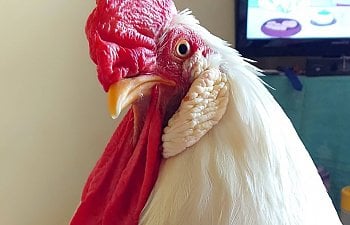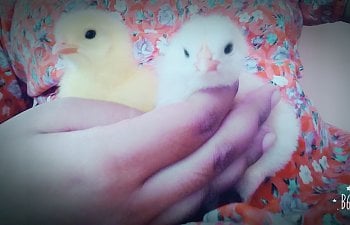We are about to discuss the topic and that's white diarrhoea ..
White poop can be trigger too many things .
A healthy chicken poop is firm solid in consistency and having a white cap of urates on top of it . that's normal poop .sometimes chicken diet makes changes into colors like
often chickens who like to eat dark fruits or vegetables will poop Blue , Purple Poop . There's nothing to worry when you are giving plenty of dark color fruits chicken poop will be dark as well .
Drinking Lots of water in 100-109°F temperature makes chickens overheated and they start releasing their heat through poo ..
In 40°C you may notice a poop like water that's also normal in summers .
White Poop Is something out of the corner you may notice chicken who poop white , slimy , no greens just white
and she's lethargy , inappetence and weak .
You may also.notice she's looking puffed up and losing weight .she's rattling wheezing and sneezing often .
Eyes are foamy or watery (not clear) , clear white or cheesy liquid coming from.nostrils . That's the SYMPTOMS OF CRD ,(CHRONIC RESPIRATORY DISEASE) caused by Mycoplasma gallisepticum (MG) is a bacteria- like organism that causes respiratory disease primarily in chickens .
CRD is highly contagious and spread like fire in flock if one show symptoms its necessary to treat entire flock .
Most old chicken keepers know about CRD and very well at treating it .
CRD has 3 stages :-
Stage 1
The sudden appearance of wetness around the eye, sometimes referred to as one eye colds, may be due to Mycoplasma gallisepticum infection. One eye colds appear as wetness around the eye with minimal swelling of the eyelids. This type of eye condition may also be the result of stress factors such as drafts or vitamin A deficiency. When detected at this stage, the best treatment method is to apply an appropriate eye cream prescribed by a veterinarian. In most cases, this treatment will clear the eye within 2 days. When no response is seen, the disease is likely to progress to stage two or underlying diseases may be complicating the infection.
stage 2
As the infection progresses, further symptoms may include swelling of the orbital sinus ("donut" shaped swelling around the eye), pussy eye discharge, sticky eyelids and open mouth breathing. Afflicted birds and the entire flock should be treated when this stage of the disease is seen. Treatment involves the administration of a combination of antibiotics (e.g. doxycycline hydrochloride and tylosine tartrate) into the drinking water for 7 days. An appropriate eye cream is applied to those birds with eye symptoms for 2 days. To accelerate recovery and help reduce the effects of any stressful factors, Turbobooster and E-powder should be mixed into a seed treat each day for 7 days. For stage two of this disease this treatment should give a good response. A poor response indicates that underlying stress factors remain and if not seen to, the disease will progress to stage three.
Stage 3
More advanced symptoms of Mycoplasma gallisepticum infections include a swollen cere, red eyes, cheesy eye discharge, pasted eyelids and an open (gaping) mouth. These more serious symptoms are a good indication that complicated CRD is present and these birds will not respond well to treatment. Those birds with longstanding and complicated Chronic Respiratory Disease should be culled as it is too late for a full recovery and they will spread the disease to other birds in the flock.
The remainder of the flock should receive a 5 day treatment course as described for stage two of this disease.
Birds that have recovered from clinical signs of the disease have some degree of immunity. Such flocks, however, carry the organism and can transmit the disease to susceptible stock by direct contact or by egg transmission to their progeny.
The complicated form of CRD occurs when other underlying diseases are involved. A virus infection called Infectious bronchitis (IBV) is a highly contagious disease causing acute illness, coughing, sneezing and impaired kidney function. IBV may precipitate outbreaks of Mycoplasma gallisepticum, although when present together, mortality in adult flocks is negligible. There is however, a marked reduction in egg laying and mortality in broilers can be high especially during colder months.
E.coli infections have also been found to be a frequently complicating organism while other diseases which may complicate CRD include Mareks disease (Herpes), ILT (infectious laryngo-tracheitis) and Pox virus.
Prevention is the key!
It is difficult to prevent infections caused by Mycoplasma gallisepticum because the disease is transmitted by egg and any new birds must be free of the disease. Vaccinations have not proven to be a successful preventative measure because CRD is so often complicated by underlying diseases. Careful management strategies that minimise stress and the ability to determine the stage of CRD are important preventative measures in the treatment and long term prevention of Mycoplasma gallisepticum infections. The attached health programmes help to protect flocks from CRD.
Home Cures :-
• Capsicum
• Garlic
• Turmeric powder
• Oragano / Oil
• Mint Tea
• Fennel Tea
• Black Pepper
• Apple Cider Vinegar
Thus Provided Home Cures Will Able To Prevent The Mild Cases & Give Immunity Boost In Serve Or serious infections Medication is for 3-5 days .
Medication For CRD :-
• Tylan
• Tylosin
• Doxycycline
• Oxytetracycline
• NeoDox (Neomycin & Doxycycline )
Best For Deep Seated Infection (Repeat After 4th Week In Chicks)
• Tetracycline
• Betryl

Hope it helps
Thanks!
White poop can be trigger too many things .
A healthy chicken poop is firm solid in consistency and having a white cap of urates on top of it . that's normal poop .sometimes chicken diet makes changes into colors like
often chickens who like to eat dark fruits or vegetables will poop Blue , Purple Poop . There's nothing to worry when you are giving plenty of dark color fruits chicken poop will be dark as well .
Drinking Lots of water in 100-109°F temperature makes chickens overheated and they start releasing their heat through poo ..
In 40°C you may notice a poop like water that's also normal in summers .
White Poop Is something out of the corner you may notice chicken who poop white , slimy , no greens just white
and she's lethargy , inappetence and weak .
You may also.notice she's looking puffed up and losing weight .she's rattling wheezing and sneezing often .
Eyes are foamy or watery (not clear) , clear white or cheesy liquid coming from.nostrils . That's the SYMPTOMS OF CRD ,(CHRONIC RESPIRATORY DISEASE) caused by Mycoplasma gallisepticum (MG) is a bacteria- like organism that causes respiratory disease primarily in chickens .
CRD is highly contagious and spread like fire in flock if one show symptoms its necessary to treat entire flock .
Most old chicken keepers know about CRD and very well at treating it .
CRD has 3 stages :-
Stage 1
The sudden appearance of wetness around the eye, sometimes referred to as one eye colds, may be due to Mycoplasma gallisepticum infection. One eye colds appear as wetness around the eye with minimal swelling of the eyelids. This type of eye condition may also be the result of stress factors such as drafts or vitamin A deficiency. When detected at this stage, the best treatment method is to apply an appropriate eye cream prescribed by a veterinarian. In most cases, this treatment will clear the eye within 2 days. When no response is seen, the disease is likely to progress to stage two or underlying diseases may be complicating the infection.
stage 2
As the infection progresses, further symptoms may include swelling of the orbital sinus ("donut" shaped swelling around the eye), pussy eye discharge, sticky eyelids and open mouth breathing. Afflicted birds and the entire flock should be treated when this stage of the disease is seen. Treatment involves the administration of a combination of antibiotics (e.g. doxycycline hydrochloride and tylosine tartrate) into the drinking water for 7 days. An appropriate eye cream is applied to those birds with eye symptoms for 2 days. To accelerate recovery and help reduce the effects of any stressful factors, Turbobooster and E-powder should be mixed into a seed treat each day for 7 days. For stage two of this disease this treatment should give a good response. A poor response indicates that underlying stress factors remain and if not seen to, the disease will progress to stage three.
Stage 3
More advanced symptoms of Mycoplasma gallisepticum infections include a swollen cere, red eyes, cheesy eye discharge, pasted eyelids and an open (gaping) mouth. These more serious symptoms are a good indication that complicated CRD is present and these birds will not respond well to treatment. Those birds with longstanding and complicated Chronic Respiratory Disease should be culled as it is too late for a full recovery and they will spread the disease to other birds in the flock.
The remainder of the flock should receive a 5 day treatment course as described for stage two of this disease.
Birds that have recovered from clinical signs of the disease have some degree of immunity. Such flocks, however, carry the organism and can transmit the disease to susceptible stock by direct contact or by egg transmission to their progeny.
The complicated form of CRD occurs when other underlying diseases are involved. A virus infection called Infectious bronchitis (IBV) is a highly contagious disease causing acute illness, coughing, sneezing and impaired kidney function. IBV may precipitate outbreaks of Mycoplasma gallisepticum, although when present together, mortality in adult flocks is negligible. There is however, a marked reduction in egg laying and mortality in broilers can be high especially during colder months.
E.coli infections have also been found to be a frequently complicating organism while other diseases which may complicate CRD include Mareks disease (Herpes), ILT (infectious laryngo-tracheitis) and Pox virus.
Prevention is the key!
It is difficult to prevent infections caused by Mycoplasma gallisepticum because the disease is transmitted by egg and any new birds must be free of the disease. Vaccinations have not proven to be a successful preventative measure because CRD is so often complicated by underlying diseases. Careful management strategies that minimise stress and the ability to determine the stage of CRD are important preventative measures in the treatment and long term prevention of Mycoplasma gallisepticum infections. The attached health programmes help to protect flocks from CRD.
Home Cures :-
• Capsicum
• Garlic
• Turmeric powder
• Oragano / Oil
• Mint Tea
• Fennel Tea
• Black Pepper
• Apple Cider Vinegar
Thus Provided Home Cures Will Able To Prevent The Mild Cases & Give Immunity Boost In Serve Or serious infections Medication is for 3-5 days .
Medication For CRD :-
• Tylan
• Tylosin
• Doxycycline
• Oxytetracycline
• NeoDox (Neomycin & Doxycycline )
Best For Deep Seated Infection (Repeat After 4th Week In Chicks)
• Tetracycline
• Betryl

Hope it helps
Thanks!


